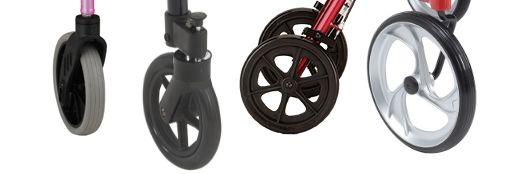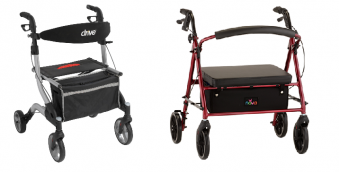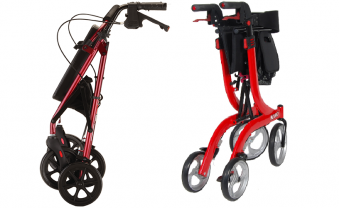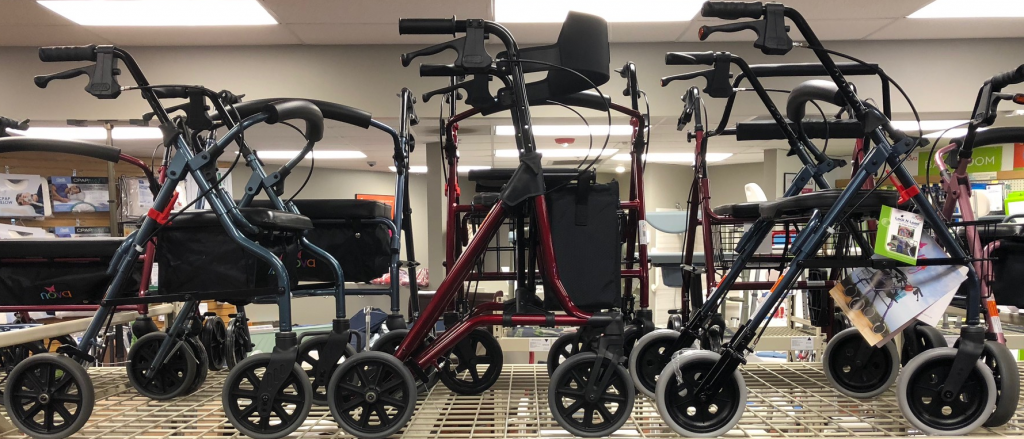Choosing a rollator (or rolling walker) can be a difficult task. Every rollator manufacturer offers many choices and, to be frank, they all look the same. You have to look closely at each rollator model to see features it offers that other models from the same manufacturer do not. So where do you start when you need to choose the best rollator for your needs?
There are many features you can look at when shopping for a rollator. Some of these features may seem inconsequential, but they are actually very important. Things like wheel size, for instance, can make a huge difference. We’re going to go over the most important things you should look at when purchasing a new rollator.
The Features on “Every” Rollator
Any rollator worth its salt will have several key features—if it doesn’t it may be time for you to check out a different brand. Every rollator you take a serious look at should have these features; 4 wheels (larger than 5”), hand brakes, a padded seat and backrest, a basket or bag of some sort, and the ability to fold up (for storage and travel).
The features listed in the previous paragraph can serve as a sort of ‘checklist’ for what you should look for when purchasing a new rollator. Each of the items on the list can be broken down a bit, however, so you can find exactly the feature that suits your needs.
Wheels
Rollators are built with increased mobility as the main focus. Having 4 wheels is a huge mobility upgrade from the ‘traditional’ silver walkers of the past. The wheels on rollators come in many sizes and can be made with different materials. You need to consider a few things when looking at the wheels on a candidate for your new rollator:
- Wheel Size: The minimum size you want to look for on a rollator is 6” wheels. Regular 2-button walkers have 5” wheels at their largest. You want to upgrade from that for better mobility. The larger the wheels, the easier it will be for you to traverse tough terrain. If you plan on spending a lot of time outdoors, look for large wheels. 10-12” caster wheels are available on some heavy-duty models—great for ‘offroading!’
- Wheel Material: Most of the wheels on rollators are made of plastic. This is usually fine, as it holds up really well over time. If you have hardwood floors or visit family who has smooth floors you may want to upgrade. Rubber wheels or rubber/plastic composite wheels are great options that will give your walker some grip on smoother surfaces.

Wheel styles: Small rubber, small plastic, large plastic, large rubber.
Hand Brakes
The most important feature on any walker with 4 wheels is the handbrake setup. Hand brakes give the user some control over how fast they are going, especially on ramps. What most people don’t realize, however, is that the brakes have an even more important function—locking so the user doesn’t fall when trying to sit down!
Without a locking feature, most rollators would, well, roll away when someone tries to sit down. Many brake rigs are available and there are a few important features you will want to take a look at when evaluating your options.
- Brake Handle Style: The brake handles on rollators made by different manufacturers look and feel different. Styles include a ‘bar’ handle (no loop or closure), a semi-closed handle (a loop with an opening), or a full-loop handle (a closed loop). Bar handles are the most common and will work for anyone. Semi-closed and loop handles work well (especially for people with limited dexterity—it keeps their hand on the brake handle) but cannot fit those with larger hands in most cases.
- Brake Cable: Brake cables on most rollators are sleeved on the outside of a walker. Most people will never notice their brake cables, but if you have a home with small doorways or tight spaces the cables may get caught on household objects. If you live in a smaller home, you may want to check out a rollator option that has internal brake cables. Be warned that some internal brake cables are very difficult to replace—you will definitely want to ask your salesperson how difficult fixes for the rollator you’re testing can be. External brake cables are the most common and are the easiest to repair. If you’re ever concerned about the cables catching on something, get some zip ties! It’s an easy fix and won’t affect your brakes.
- Brake Locking: The brake system on every rollator is going to feel different. Even models from the same manufacturer can feel different. You will want to test out the brake locking on models you like to see if they are hard or easy to lock. The physical strength of rollator users spans the whole strength spectrum—make sure the brake is easy for you to lock while still having a firm hold on the wheels.

Bar, semi-closed, and loop brake styles.
Padded Seat and Backrest
Rollators differ from traditional walkers in many ways, but one of the biggest differences is the seat. Old-fashioned walkers were not meant to be used for long distance walks. Rollators were designed with increased mobility in mind. With increased mobility comes more physical exertion. With more physical exertion comes the need for a break—thus the rollator seat!
The seats on rollators come in various sizes, shapes and padding styles. Most rollator seats and backrests are not built for comfort—you shouldn’t be taking long breaks—but there are certainly options that are more comfortable than others. It is important to find a seat that fits you comfortably if you think there is any situation where you will need to rest.
- Seat Width: The first thing to look at in a rollator seat is how wide it is. People come in all sorts of shapes and sizes. Most standard rollators will comfortably seat anyone up to 250 lbs. The usual weight capacity for a rollator is 300 lbs., but it can be a tight squeeze. Wider seats are available, and, in most cases, the wider seats offer a greater weight capacity. If you have any issues with space on regular chairs or recliners, you will want to try out rollators in person to see how the seat feels.
- Seat Style/Padding: Seat and backrest padding comes in many forms. Some padding is basically non-existent—a bare plastic seat with a thin rubber backrest cover. Some padding is a rubber seat pad with foam backrest padding. Some rollators even have canvas seats with contoured backrests. All of the seat and backrests styles feel different. If you are planning on regularly using the seat, you will need to try out different options to see what feels best.
- Seat Height: Rollator users come in all shapes and sizes; this includes height! Most rollators have a set height, usually in the range of 5’2”-6’2”. Taller people (6’3”+) know how hard it can be to find a specific product in a size that suits their needs and rollators are no exception. Thankfully most rollator manufacturers offer models for taller folks. Some rollators even have the ability to adjust to a wider height range, with adjustable handles and If you are a taller person (or shorter than 5’0”) you will want to try out a variety of seat heights. Getting up from a rollator seat that is too low or too high can be very strenuous and you don’t need that!

Left: Canvas material. Right: Padded foam material.
Storage
When you are using a rollator, you are using it most of the time when you leave the house. It’s difficult to carry things while using a rollator, and things you set on the seat can fall of if you hit a bump. This is the reason any rollator worth it’s salt comes equipped with storage of some sort. The two types of storage that come standard with most rollators are bags and baskets.
- Bags: Bags are usually located under the seat on a rollator. The seat flips up and you have a bag that will fit a good-sized purse. The bag is usually canvas or vinyl material and will hold up against regular wear and tear. The other location where rollator bags are commonly located is hanging on the front, either from the backrest or the seat. The front hanging bags have less space but are easier to reach than under-the-seat bags.
- Baskets: Rollator baskets come in the same locations and with the same limitations as bags with a few differences. Baskets are made of metal wire, making them great for holding heavier objects. The metal wire is also very porous—great for containers of liquid that sweat, not so great for small objects.
- Options: Extra bags and baskets are available for additional rates and will work with most rollator models. In most cases you can choose where the extra bag or basket will be located. You can even get cup holders for specific models!

Canvas under-seat bag and a wire basket.
Folding
Rollators are built to take with you when you run errands or go out socially. It is for this reason that they have the ability to fold up and fit in tighter spaces when not being used. Rollators can fold in several different ways—allowing users with different issues physically or domestically (smaller home) to pick the best option for their needs.
- Under-the-Seat: The vast majority of rollators fold by pulling up on either a handle or support bar hidden under the seat. If you are looking at a walker with a bag under the seat, there is probably a handle sewed into the bag, making it easy to grab and fold. If there is no bag, you will have to pull up on the crossbar/support bar underneath the seat—still easy, just not as pretty.
- Side-to-Side: Newer rollator models have been moving towards a ‘side-to-side’ fold. The side-to-side fold usually involves pressing a button or pulling a latch, allowing the user to push the handles together, folding the walker in the middle. The advantage of the side-to-side fold is that you can still push the rollator while it is folded—great for storage! The downside of the side-to-side fold is that the seat options are limited—hard or padded plastic does not fold up very well.
- Fold Locks: Some rollators come with fold locks. Fold locks allow the user to lock the walker when it is folded, preventing it from opening up during travel or storage. Ask your salesman if the rollator you are looking at has a folding lock option.

A middle folding VS side folding rollator.
What to Do Next?
Now that you have taken this crash course on features in order to pick the best rollator for your needs, what’s next? Well… you should probably go out and try a few to see how they feel! We could describe things to you all day, but actually trying a rollator can make all the difference in the world.
Many models are available, including some that I didn’t have time to bring up in this article. If you are looking for a specific rollator function, chances are that it exists—you just have to find a place that can help you locate it.
Where is that place? Well, we have a huge rollator selection on the floor ready to test, a staff of trained employees and a large backstock of specific product styles, so… stop by Oswald’s today! If you have any questions, don’t hesitate to give us a call or send us an email. We’re here to help!

Come see our great in-store selection! Try out a rollator today.


